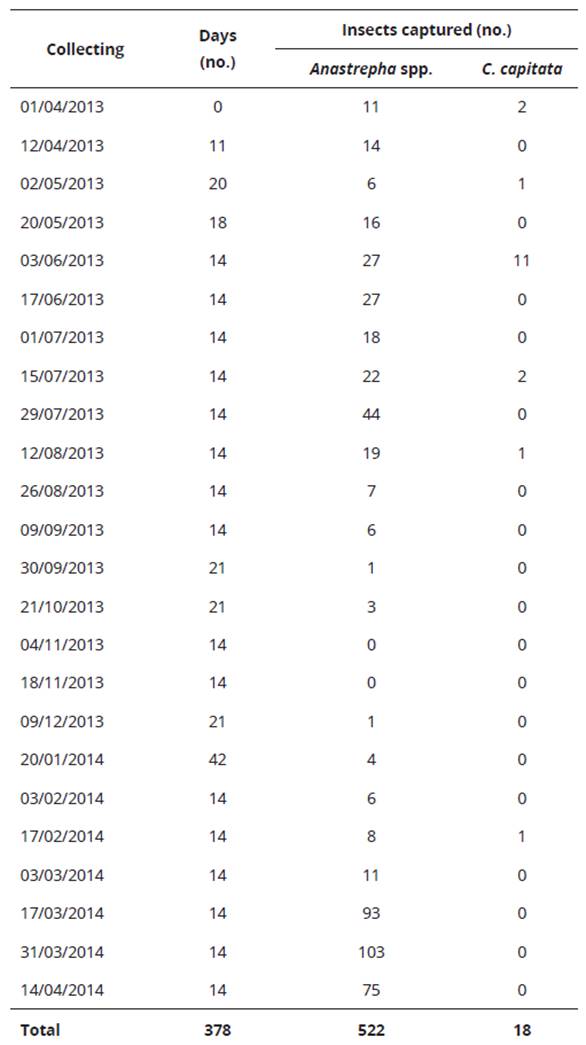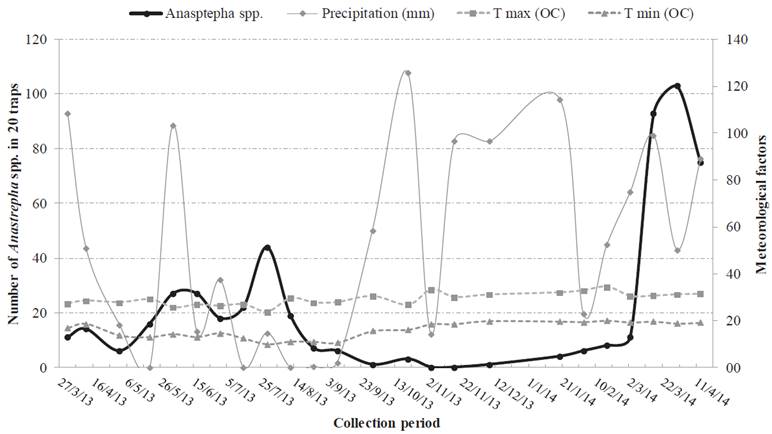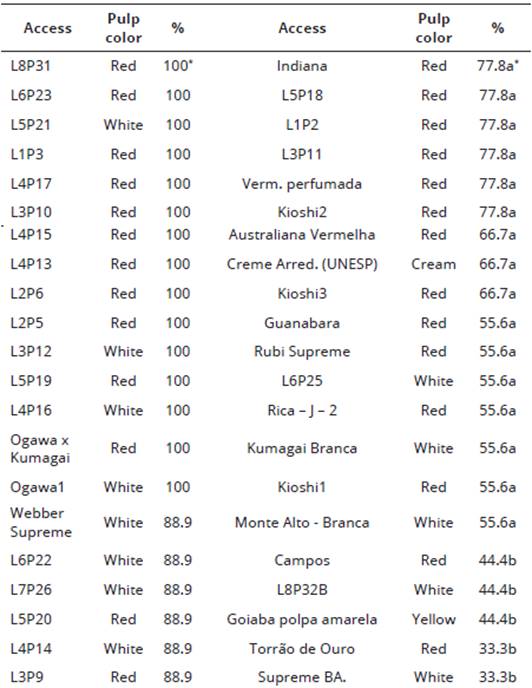Introduction
Guava (Psidium guajava L.) fruit presents prominently among the tropical fruit, due mainly to the large variety of products and sub-products, uses and forms for consumption (Campos et al., 2013). In Brazil, commercial guava orchards are concentrated mainly in the Southeast and Northeast, being the States of Sao Paulo and Pernambuco the largest producers.
Despite the economic importance on the world scene, the exports of Brazilian fresh guava fruits are still unimpressive, almost exclusively dependent on the internal market (Costa et al., 2007). Fruit flies (Diptera: Tephritidae) in Brazil- ian orchards are considered the biggest obstacle in the marketing and export of fruit production (Hernandes et al., 2013). The fruit flies present great taxonomic diversity. Comprise more than 5,000 species belonging to the Tephritidae family distributed by the world (Montes et al., 2011). Damages occur due to oviposition by females in the developing fruits, causing depreciation of product for consumption (Nunes et al., 2013). Indirectly the damage caused through the hole made for laying and larval feeding facilitates contamination with micro-organisms causing rotting of the fruits favoring other sanitary problems (Nascimento et al., 2000).
Many fruit trees of the family Myrtaceae are the primary host of fruit flies (Birk and Aluja, 2011). In Brazil, Ceratitis capitata (Wied.) and more than 11 species of Anastrepha have already been reported infesting guava fruit (Jesus Barros et al., 2012). Fruit flies floats due to a succession of primary or alternative hosts, environmental complexity and abiotic factors (Montes et al., 2011). With monitoring of population, it is possible to determine the insect fluctuation in a specific area, to detect exotic or quarantine species, enabling a more precise characterization of pest population in qualitative and quantitative terms (Maciel et al., 2017).
Climate components can directly or indirectly influence the behavior of pests. These factors act directly on mortality and on the performance of pests through changes in oviposition, feeding, growth, and invasion to new areas (Hopkins and Memmot, 2003). Insects are adapted to specific temperature variations. Temperature is often the most damaging environmental factor influencing insect populations and distribution (Damos and Savopoulou-Soultani, 2012).
According to Salles (2000) at temperatures below 10 °C and above 35°C there was no development of any of the phases of Anastrepha fraterculus (Wied.). Precipitation and relative humidity also can exert influence on fruit flies, since the pupa phase occurs in the soil and the need for moisture to promote the emergence of adults (Aluja, 1994).
The population fluctuation of fruit flies over a period depends on a set of related factors, such as host fruits, the season of the year and alternate hosts, among others. Thus, rainfall can lead to a greater quantity of fruits, which may offer a greater supply of development sites for tephritids larvae. Therefore, various biotic or abiotic factors may have an influence on the population peaks of the flies (Ronchi-Telles and Silva, 2005).
Information on the population fluctuation of fruit flies and their relation with biotic and abiotic factors should be properly obtained and interpreted, for regional control of insect (Aluja et al., 2012). Therefore, the objective was to estimate the population fluctuation of fruit fly and the damage caused by the infestation of fruits in different genotypes of guava cultivated in an organic system and analyze the correlations between the population fluctuation of pest and meteorological factors.
Material and methods
The experimental work was developed in APTA (Agéncia Paulista de Tecnologia dos Agronegócios) Regional Centre-North Pole, in Pindorama-SP, 21 13’ South latitude and 48 55’ longitude West, 527 m altitude, with yearly average temperature of 22.8 °C, annual average rainfall of 1,390.3 mm and average annual relative humidity of 71.6%. According to the Koppen classification (Koppen and Geiger, 1928), the climate is Aw type, defined as tropical humid, with a rainy season in summer and dry in winter.
Plants from Germplasm Bank of guava were used, containing 85 genotypes, with 15 years old, with three plants/genotype, cultivated in an organic system, 6 x 5-meter spacing. Through the analysis of soil, it was done an application on the surface of 1.5 ton/ha of dolomitic limestone in total area and 20 L of a filter cake, around the trunk, in each plant. The control of spontaneous plants was accomplished by cutter motor and manual weeding. In July 2012, nine months before to start the research, the plants have suffered a drastic pruning, and the main trunk presented a final height of 1.20 meters from the ground.
For monitoring the population fluctuation of fruit flies in experimental field, 20 yellow sticky traps (Bio Trap-Biocontrol®) were used, with the measures of 24.5 x 10 cm, and glue on both sides, spaced at about 50 m from each other in internal branches in the middle part of the trees, at a height of 1.5 m from the ground. The assessments began in April 2013, when the trees have reached a uniform volume of the cup and finished in April 2014. The traps were kept in the field for 14 days in most cases and replaced by new ones, without interruption. For evaluation, each trap removal of the plant was wrapped in a plastic folder and taken to the lab, for quantified and registered the fruit flies captured. For Anastrepha spp. the classification has been carried out at the genus level by difficulty in highlighting the insect from the trap without damaging its structure, similar to works of Calore et al. (2013) and Duarte et al. (2013).
The association between the number of fruit fly of the genus Anastrepha spp. captured in the traps and meteorological variables was evaluated by Pearson’s correlation coefficient (P < 0.05). Daily records of the temperatures (°C) maximum, minimum and average and precipitation (mm) were obtained at the weather station located within the research unit, distant 400 m from the orchard. For temperature, were used the media recorded in the period that the traps were in the field; for precipitation, accumulation. The analyses were made with statistical program Assistat (Silva and Azevedo, 2006). The correlation was not performed for the species C. capitata by the small amount specimens captured.
For evaluation of infestation, nine fruits not bagged for each genotype at the ripe stage were collected and transported to the laboratory, and cutter for check larvae of fruit flies. Fruits with at least one larva were considered infested. The total number of fruits and the number of infested fruits were converted to the percentage of infestation by the formula: % fruit infestation = (number of infested fruit/total fruit) X 100. The percentage of infested fruit were compared by the Scott-Knott test at the 5% probability (Scott and Knott, 1974).
Results
The fruit flies of the genus Anastrepha resulted in a total of 522 individuals between males (207 specimens) and females (265 specimens) collected in 20 yellow sticky traps being the genus of fruit flies main. The total number of flies of the species C. capitata caught was only 18 specimens (Table 1).
Table 1 Number of fruit fly captured in 20 yellow sticky traps installed in the orchard of guava, in different collections. APTA (Agencia Paulista de Tecnología dos Agronegócios) Regional Centre-North Pole, Pindorama, Brasil.

The highest population densities of fruit fly of the genus Anastrepha spp. occurred in the second half of March 2014, the fruiting season of the orchard. The population peak occurred in the 23rd collecting (March 31), with a total of 103 flies, followed by the 22nd and 24th collections (17 March and 14 April), with a total of 93 and 75 flies, respectively (Figure 1, Table 1).

Figure 1 Number of Anastrepha spp. captured in 20 yellow sticky traps, and occurrence of meteorological factors in orchard of guava, in April 2013 through April 2014. APTA (Agencia Paulista de Tecnología dos Agronegócios) Regional Centre-North Pole, Pindorama, Brasil.
The smallest population densities of Anastrepha spp. occurred in the period from September 2013 to February 2014 (Figure 1), time of the beginning of flowering until fruits, without ripe fruits.
The correlations between the meteorological factors temperature (mínimum and maximum), precipitation and population fluctuation of fruit flies of the genus Anastrepha were not significant for all three parameters evaluated. The percentage of fruits infested by larvae of fruit flies in nine fruits evaluated per genotype is illustrated in Table 2. The genotypes were divided into three groups, most with high infestations of 55.6% to 100% fruits containing insect larvae. The genotype IAC-4-Cica did not present any infested fruit, among 50 evaluated, without differing statically from Taquaritinga Comum genotype (11.1% infestation), both of red pulp.
Table 2 Percentage of fruit attacked by fruit fly in nine fruits evaluated for access. APTA (Agencia Paulista de Tecnologia dos Agronegócios) Regional Centre-North Pole, Pindorama, Brasil.

* Averages followed by the same letter in the column do not differ, by Scott-Knott test, at 5% probability. ** Significant, 1% probability; NS Not significant. Statistical analysis with the data transformed into
Discussion
In the present work, the highest incidences of fruit fly of the genus Anastrepha coincided with the time of fruiting of the orchard, as expected, since the species looking for ripe fruit for ovipo sition (Calore et al., 2013). Similar results were obtained by various authors and diverse cultures: Araújo et al. (2008), Duarte et al. (2013), Calore et al. (2013) and Maciel et al. (2017) for guava trees; Alberti et al. (2012), to peach and passion fruit; Santos et al. (2013), for mangoes.
Santos et al. (1998) observed that the peak population of flies of the genus Anastrepha in guava orchard in Mossoró-RN-Brazil, occurred in June, so in a different time from that reported in this survey. Araújo and Zucchi (2003), in a similar study, found that the highest levels of infestation and population peaks of A. zenildae occurred from May to July. The authors report that in semiarid regions, rainfall, coupled with hosts are the dominant factors in the population peaks and not only fruits. In this study, it was observed that the population peak of tephritids coincided with the season of fruiting, and had no relationship with precipitation.
The smallest population densities of Anastrepha spp. occurred in the period from September 2013 to February 2014 (Figure 1), time of the beginning of flowering until fruits, so without ripe fruits. These results corroborate Ronchi-Telles and Silva (2005) who reported that host fruit is the most important factor in determining the occurrence and population fluctuation of fruit flies and not abiotic factors.
The low occurrence of C. capitata (Table 1) was also observed by other authors. Duarte et al. (2013) studying population fluctuation of fruit fly in guavas cultivated in conventional and organic yield systems, reported that population density of adults of fruit flies were represented by the genus Anastrepha totaling 97.02% (5,918 specimens) of the total number of tephritids collected in the evaluation period, for organic orchard, and the capture of C. capitata corresponded to 2.98%. Despite C. capitata attack guava (Zucchi, 2001), Raga et al. (2006) studying guava genotypes to natural infestation by fruit flies, in Monte Alegre do Sul-SP-Brazil, through obtaining puparia of tephritids from fruits, not recovered adults of the species C. capitata during the evaluations. The authors reported that probably this found was due to the low density of population of this species in evaluation times, less than 0.03 fly/trap per day using McPhail traps with hydrolyzed protein.
Several researchers, in Brazilian studies with population fluctuation of tephritids, also observed the predominance of fruit flies of the genus Anastrepha (Garcia and Corseuil, 1998; Uramoto et al., 2003). Silva et al. (2010) state that the diversity and dominance of Anastrepha spp. occurs mainly based on climate, altitude, geographical location, hosts and adjacent orchards from the singular area. Araújo et al. (2005) and Silva et al. (2007) report that based on infestation levels and regional distribution, guava is considered the primary host of the genus Anastrepha. Aluja et al. (1996) evaluating the population fluctuation of fruit fly in commercial orchards in southern Mexico have suggested that this type of behavior is considered normal, since although several species of tephritids are present in an orchard, just one or two species account for more than 90% of all fruit flies collected in traps. Diniz (2016) in an experiment carried out on the same Germplasm Bank of the present study found that all flies of the genus Anastrepha captured were identified as A. fraterculus. According to Aluja (1999), A. fraterculus is mainly associated to the Myrtaceae family.
The lack of correlation between the meteorological factors and population fluctuation of fruit flies was verified by other authors, with varied results. Calore et al. (2013) in similar experiment verified no correlation with population fluctuation of fruit flies with precipitation, but found significance with temperatures (minimum, average and maximum), indicating that the increase of population of fruit flies was favored by highest temperatures. Santos et al. (2017) evaluated the population fluctuation of A. fraterculus in apple orchards and the meteorological variables temperature, precipitation, and relative humidity, in three seasons, and observed correlation between the number of flies and temperature only in one season (2010/2011), and none correlation with precipitation, in all seasons evaluated.
Temperature is one of the main factors that interfere in the biological cycle of A. fraterculus (Machado et al., 1995; Salles, 2000; Taufner et al., 2000). The optimum range for development is between 15.3 °C and 26.8°C, being necessary 430.6 hours (thermal constant expressed in degrees/day) with temperatures above 10.72 °C for the complete biological cycle of the insect (Machado et al., 1995). This condition of temperature was observed throughout the monitoring period, in the region of this study, may be the cause of no correlation between temperature and population fluctuation, being the presence of ripe guava fruits the preponderant factor.
The percentage of fruits infested by larvae of fruit flies in Table 2 highlighted the geno type IAC-4-Cica, for being the only one who did not present any infested fruit, without differing from Taquaritinga Comum genotype (11.1%), both of red pulp. Thus, both genotypes presented early crop, an important fact to be taken since the area of the experiment was still with a low occurrence of the insect.
The genotypes Campos, L8P32B, Goiaba polpa amarela, Torrao de ouro, Supreme BA, L2P4 and Supreme also had few fruits attacked without statistical differences (Table 2). All evaluations were performed with ripe fruits, respecting their natural maturation. In organic farming, for the absence of chemical products, fruits are intended almost entirely to industry, given the difíiculty of obtaining fruits without fruit fly larvae. The practice of bagging fruit is quite costly, demand a lot of labor and consequently increases in yield costs. However, it is still the only way to get healthy fruit for fresh consumption and for export. Them it is so important to work with materials that offer resistance to insect attack.
Raga et al. (2006) evaluated 11 guava genotypes of natural infestation by Anastrepha spp., in Monte Alegre do Sul-SP-Brazil, by obtaining puparia from fruits, verified that the L2P4 genotype presented the lowest infestation index of the experiment, with averages of 2 to 5 puparia per fruit. The authors still reported that Indiana genotype showed the highest rate of infestation, reaching 49 puparia in a single fruit. Similar data were obtained in the present experiment, where the L2P4 genotype also showed low infestation (33.3%, Table 2), indicating material with potential resistance to fruit fly. Indiana genotype presented 77.8% of infested fruit, without differing significantly from the genotypes with 100% infestation. These results show that the susceptibility and/or resistance of a genotype is himself associated, and not with the weather, geographic location, and other, since the behavior of the materials was similar in both study sites, with different weather.
Conclusions
The fruit flies of the genus Anastrepha are found in greater quantity in guava trees, in the Central North of Sao Paulo State, Brazil.
The highest population densities of fruit fly Anastrepha spp. occurs in the second half of March 2014, coinciding with fruiting phenology of orchard.
There is no correlation between the meteorological factors and population fluctuation of the fruit fly, for the assessment time.
The genotype IAC-4-Cica did not present fruit infested, and Taquaritinga Comum presented only 11.1% of infested fruit.














